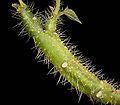We included 157 studies published up to June 2014, which examined 10,550 people. Participants included women with a mean age of 25 years. There was considerable variation in the quality of how the studies were conducted; more than half were not blinded and this may have had an impact on the reporting of the outcomes. Most studies were carried out in single centres in Europe and lasted six to 12 months. A range of treatments were evaluated, mostly in single studies. These included a few topical treatments, lifestyle modification, oral contraceptive pills (OCPs), medication to inhibit the effect of hormones that are responsible for male traits, and combination therapies. Participant-assessed improvement and impact on quality of life were evaluated in a minority of the studies, whilst the majority of the studies measured physician-assessed reduction in hirsutism, as well as androgen levels in the blood. Half of the studies reported adverse events and around one-third other signs and symptoms, e.g. oily skin and menstrual irregularities that might be due to an increase of androgen levels in the blood.
Oral contraceptive pills reduced the amount of hairs, but the reduction was not consistent across the studies, although two OCPs (ethinyl estradiol 35 µg + cyproterone acetate 2 mg compared to ethinyl estradiol 30 µg + desogestrel 0.15 mg) appeared to be effective in a way that can be considered important for women with hirsutism.
Of the antiandrogen drugs, flutamide was considered to be more effective than placebo by both the women and the doctors. Spironolactone was also effective, but data were only available for the physicians' assessments. Finasteride did not show convincing effectiveness based on the evaluations of the hirsute women and those made by the investigators. The addition of cyproterone acetate (an antiandrogen) to OCP seemed to enhance the beneficial effect of OCPs on hair reduction.
Insulin sensitisers (antidiabetic drugs) and lifestyle modification did not have any demonstrable benefit in terms of the severity of hirsutism. Unfortunately, the self assessments by the women, as well as the impact of hirsutism on their quality of life, were outcomes that were insufficiently addressed in the studies.
The adverse events reported with the different drugs are well known, i.e. pain in the stomach and intestines, breast tenderness, reduced libido and dry skin with flutamide and finasteride; irregular bleeding with spironolactone; nausea, diarrhoea and abdominal bloating with metformin; and hot flushes, decreased libido, vaginal dryness, breast tenderness and headaches with the GnRH analogues.
There were no important differences in blood androgen levels between the different treatment groups, OCPs had a positive effect on acne, and similarly insulin sensitisers improved the menstrual pattern.
We were expecting to find evidence that combined therapies of an OCP with an antiandrogen were more effective than, for example, OCPs alone, but the lack of studies did not allow us to draw these conclusions.
Overall we concluded that OCPs (especially with antiandrogenic activity), OCPs combined with cyproterone acetate, flutamide and spironolactone are effective in treating hirsutism. However, additional cosmetic measures (epilating, waxing, bleaching, electrolysis, laser and photoepilation) are generally required because all treatments need at least six to 12 months to reach the optimum effect. In addition, because of the distress associated with hirsutism and its impact on quality of life psychological support should be part of the treatment approach.
The overall quality of the evidence for the different outcomes was on average rated as moderate to very low. Important reasons for this were that studies were not blinded, or had a small sample size.
Authors' conclusions:
Treatments may need to incorporate pharmacological therapies, cosmetic procedures, and psychological support. For mild hirsutism there is evidence of limited quality that OCPs are effective. Flutamide 250 mg twice daily and spironolactone 100 mg daily appeared to be effective and safe, albeit the evidence was low to very low quality. Finasteride 5 mg daily showed inconsistent results in different comparisons, therefore no firm conclusions can be made. As the side effects of antiandrogens and finasteride are well known, these should be accounted for in any clinical decision-making. There was low quality evidence that metformin was ineffective for hirsutism and although GnRH analogues showed inconsistent results in reducing hirsutism they do have significant side effects.
Further research should consist of well-designed, rigorously reported, head-to-head trials examining OCPs combined with antiandrogens or 5α-reductase inhibitor against OCP monotherapy, as well as the different antiandrogens and 5α-reductase inhibitors against each other. Outcomes should be based on standardised scales of participants' assessment of treatment efficacy, with a greater emphasis on change in quality of life as a result of treatment.
